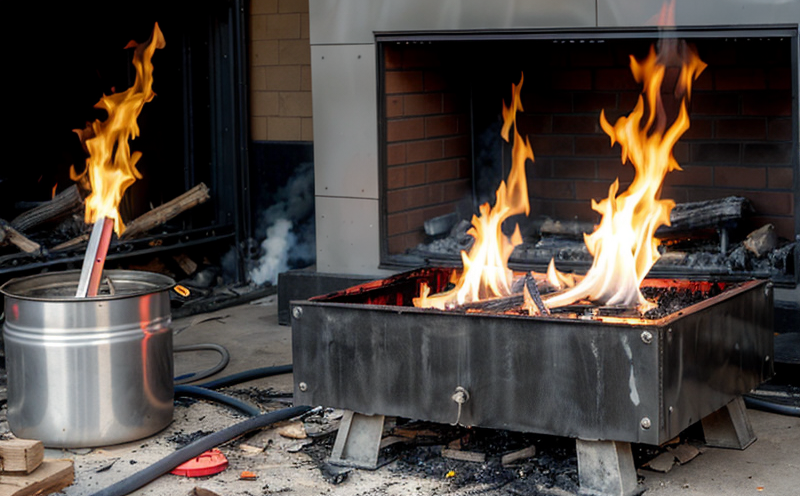EN 45545 Fire Safety Testing for Railway Materials
The EN 45545 fire safety standard is a critical requirement for railway materials and components. This regulation ensures that the materials used in rail vehicles meet stringent fire safety standards, which are essential to prevent fires and ensure passenger safety during emergencies.
EN 45545 covers various aspects of fire resistance, including smoke production, flaming combustion, and heat release rate under specific test conditions. The standard is applicable to all types of materials used in rail vehicles, such as plastics, textiles, adhesives, and other interior components that could potentially ignite or contribute to the spread of fire.
The testing procedures outlined in EN 45545 are designed to simulate real-world scenarios where a material might come into contact with an ignition source. The tests are conducted under controlled conditions to ensure consistency and repeatability, making it possible to compare results across different materials and manufacturers.
For quality managers and compliance officers, understanding the requirements of EN 45545 is crucial for ensuring that their organization meets all regulatory obligations. This standard plays a vital role in maintaining safety standards within the railway industry and helps protect passengers from potential hazards associated with fire incidents.
R&D engineers must also be familiar with this standard when developing new materials or modifying existing ones to ensure they comply with current regulations. By incorporating EN 45545 into their design processes, they can enhance the safety features of rail vehicles while meeting all necessary compliance requirements.
Procurement teams should consider specifying EN 45545 as a requirement in their material specifications when sourcing components for use in rail vehicles. This ensures that suppliers are delivering products that meet stringent fire safety standards and contribute to overall vehicle safety.
Scope and Methodology
The scope of EN 45545 includes the testing of materials used in various parts of railway vehicles, such as seating upholstery, partitions, floor coverings, and other interior components. The standard specifies detailed procedures for conducting flammability tests on these materials under controlled conditions.
- Test Setup: A standardized test chamber is used to simulate the environment where the material might encounter an ignition source.
- Specimen Preparation: Samples of the material are prepared according to specified dimensions and weight.
- Ignition Source: An appropriate ignition source, such as a burner or flame, is used to expose the sample to heat.
- Data Collection: Temperature, smoke density, and other relevant parameters are measured during the test.
The methodology involves exposing the specimen to an ignition source for a predetermined duration while monitoring various parameters that indicate the material's flammability characteristics. The results of these tests provide valuable information about the fire resistance properties of the material.
It is important to note that EN 45545 provides several different test methods tailored to specific types of materials and applications within railway vehicles. Quality managers should ensure that they are familiar with which method applies to their particular situation so that accurate testing can be performed.
Benefits
The benefits of complying with EN 45545 extend beyond mere regulatory compliance; it contributes significantly to enhancing the safety and reliability of railway vehicles. By ensuring that materials used in these vehicles meet stringent fire safety standards, manufacturers can reduce the risk of fires occurring during service.
Passengers benefit directly from this by being protected against potential hazards associated with fire incidents. The use of fire-resistant materials helps contain flames and reduces smoke production, which improves visibility for emergency responders and passengers alike.
Railway operators also experience numerous advantages through compliance with EN 45545. They can demonstrate their commitment to passenger safety by meeting all relevant regulatory requirements. This can enhance their reputation among stakeholders and improve public perception of the rail industry as a whole.
From an operational perspective, compliant manufacturers may enjoy reduced insurance premiums due to lower risk profiles associated with fire incidents. Additionally, they may be able to secure contracts more easily since many buyers now require proof of compliance with such standards.
Frequently Asked Questions
Environmental and Sustainability Contributions
Compliance with EN 45545 not only enhances safety but also plays a role in promoting environmental sustainability. By reducing the risk of fires, these materials help minimize the release of harmful pollutants into the atmosphere. This contributes to cleaner air inside rail vehicles and reduces the overall impact on public health.
The use of fire-resistant materials can also extend the lifespan of railway equipment by preventing premature degradation due to excessive heat or smoke exposure. This leads to reduced waste generation and resource consumption over time, aligning with broader sustainability goals.





